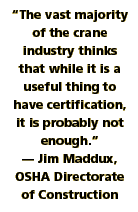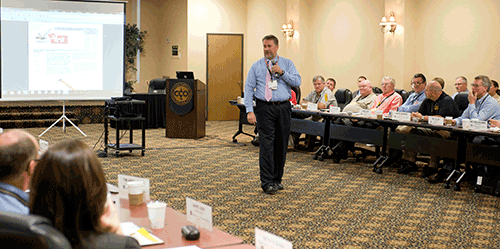 November 2013—Crane operator certification took center stage last month at the 35th Biannual Meeting of the Commission of the National Commission for the Certification of Crane Operators (NCCCO).
November 2013—Crane operator certification took center stage last month at the 35th Biannual Meeting of the Commission of the National Commission for the Certification of Crane Operators (NCCCO).
Jim Maddux, Director of OSHA’s Directorate of Construction, speaking to more than 60 NCCCO Commissioners and guests at the Maritime Institute, Baltimore, MD, confirmed that OSHA was seeking a postponement to the effective date of the new operator certification/qualification requirement so it could fix the issues that the construction industry had brought to its attention. (View PDF of Maddux's presentation.)
 “The vast majority of the crane industry thinks that while it is a useful thing to have certification, and it has a really important place, it is probably not enough,” Maddux said. “That we also need to make sure that the employee is qualified to operate the crane they are operating.”
“The vast majority of the crane industry thinks that while it is a useful thing to have certification, and it has a really important place, it is probably not enough,” Maddux said. “That we also need to make sure that the employee is qualified to operate the crane they are operating.”
So while certification could be an important component of qualification, it was not, in and of itself, the same as qualification.
In anticipation of the rule re-opening, OSHA would continue to conduct interviews with employers (23 had been completed or were scheduled to occur, Maddux said) in order to build an “information base that we need to know how to move forward.”
Maddux also presented an updated list of the “Top Ten” crane standards being cited by OSHA, noting that fully six of them related to rigging, signaling or inspection. “Documentation continues to be a big issue,” he noted, “with cranes without load chart manuals and proper hazard warnings.”
Compliance Directive Nears Publication
The lack of a Compliance Directive had certainly had the effect of “holding back” the full “qualitative and quantitative” effects of the new rule, Maddux said and, as a result, it hadn’t hit its “full stride” in terms of the safety effects it could have. However, with all the responses from its regional offices now in, the draft Directive was now nearing publication, he said, having passed through the Directorate for review by the Solicitor’s Office.
And, perhaps good news for employers and OSHA compliance officers alike, the final draft has been reduced in size from about 260 pages to slightly less than 200.
U.S. Army Corps of Engineers Updates Commissioners, Praises VCO System
Speaking earlier in the day, Jerry Balcom, Loss Control Program Manager, U.S. Army Corps of Engineers, based in Washington, DC, advised the Commission that the new edition of EM-385 Safety & Health Requirements Manual was on target for publication in the spring of 2014. There were significant changes from the last edition he noted, and he advised all those involved with Corps’ contracts to acquaint themselves with Sections 15 (rigging) and 16 (load handling equipment) in particular.

Jerry Balcom, the U.S. Army Corps of Engineers’ Loss Control Manager, who oversees all accident reporting and investigation, accident trend analysis, and lessons-learned, speaks to the full Commission.
Balcom recognized that there could be better communication between the Corps and industry. “We need to do a better job of knowing what you are doing in the field,” he said. “We want to work with you so we understand better what you do and how you do it.” He emphasized the need, often expressed by contractors, for Corps’ District offices to apply the provisions of the Safety & Health Requirements Manual “in a centralized and standardized manner.” “We need to make sure that whether you are in Portland, OR, or Portland, ME, you receive the same interpretations of U.S. Army Corps of Engineers’ requirements.”
Balcom stated he had been particularly impressed with the VCO Online Verification System that permits users to verify the current status of any CCO-certified individual. He cited one particular incident involving a Corps of Engineers contract where an operator was found to be not in good standing and was removed from the site. “We could not have done that so easily without your VCO system,” said Balcom, “so thank you for making available to us an instrument that helps to ensure the integrity of our program and the safety and health of the contractor.” The U.S. Army Corps of Engineers was one of the first government entities to register to use the VCO system.
Other Commissioners Meeting Highlights
The Commissioners were also briefed by NCCCO and International Assessment Institute staff on 2013 NCCCO program highlights, including test development and maintenance, program improvements, program features and performance, program administration, regulatory activity, ethics and discipline activities, an audit program update, and marketing and outreach activities. Of particular interest were reports on the launch of the new CCO Lift Director certification, NCCCO’s advocacy activities regarding OSHA’s decision to reopen the new crane rule, and the progress of the “Committed to Crane Safety” employer recognition program.
Three Commissioners in three distinct industry sectors were elected to new five-year terms: Walter Brumley of Shell Oil (Deer Park, TX); William "Hank" Dutton of Travelers (Oxford, GA); and John Hartwell of IUOE Local 324 (Howell, MI). Brumley and Dutton have previously served the NCCCO Commission in this capacity. Meanwhile, Commissioners Scott Lamb of IUOE Local 324 and Doug Sidelinger of Cianbro Corp. both retired from the Commission after many years of service. NCCCO thanks all of these industry representatives for their dedication and commitment to NCCCO and its mission to promote crane safety.

Doug Sidelinger (left) and Scott Lamb (right) receive plaques from NCCCO Chairman Ellis Vliet and Executive Director Graham Brent in appreciation for their years of contributions to the NCCCO Commission.
Earlier in the week, the Articulating Crane Management Committee, the Signalperson Management Committee, the Written Exam Management Committee, the Practical Exam Management Committee, and the Recognition Programs Committee all met to work on continuously improving their respective programs.
Many thanks to the meetings’ sponsors: Vial Equipment Sales & Service (Santiago, Chile) sponsored the full Commission Meeting; Morrow Equipment (Salem, OR) and Ruco Equipment (Lees's Summit, MO) sponsored the previous three days of committee meetings.
View PDF of Jim Maddux's OSHA presentation.
View a photo gallery from the Fall 2013 Commissioners Meeting.
For additional history on OSHA’s Crane Rule, see NCCCO’s OSHA Crane Rule Resource Center.